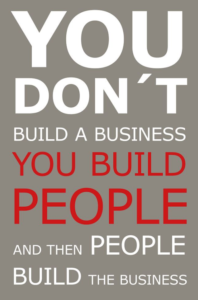
So let me ask you a question. On a scale of 1 – 10, with 1 being “You’ve got to be kidding me!” and a 10 representing, “I can’t think of a better place.” , how would you rank the sense of “Well-Being” where you work? I ask because of some conversations I’ve had over the past few weeks, two of which stand out. One individual described her work environment as almost toxic. “It is highly competitive and you need to watch your back constantly. Drop your guard and you are screwed!” When I asked, “Why do you stay?”, she looked me straight in the eye and said, “The money!” My second conversation occurred on a Sunday afternoon, and gave me reason to smile. While playing golf with a friend we initially talked about my retirement and the transition process that has occurred over the past year. As the conversation continued we focussed more on his organization. A comment he made stuck with me, “I don’t know how you did it. The people I work with are like my second family. They look out for me, I look out for them, and together we serve the needs of our clients and customers. I can’t imagine not seeing them every day.”
Is workplace well-being important? Absolutely! There is significant research to demonstrate that high employee well-being can boost satisfaction, teamwork, productivity, and even improve a company’s bottom-line. A 2015 White Paper prepared by the OC Tanner Institute revealed that, “Improved well-being does in fact have a large impact on employees, the way they work, and ultimately on the company’s bottomline. Employees who are holistically well, deliver a difference for their teams and departments. In fact, as employee well-being increases, its positive effects resonate throughout the organization and teams become more productive, more collaborative, and prepared to innovate.” So we know it works, what can be done?
Adam Friedman addresses this opportunity in his Forbes Marketing post, “Why Well-Being Matters and How to Create It At Your Company. He begins with a “Chicken/Egg” question, “Which came first? The happy employee or great work product?” He then sites research similar to that found in the Tanner Institute White Paper. Going beyond the research he provides some tips for supporting employee’s sense of well-being in the workplace:
• Build Resilience – Help staff by keeping them hopeful about the future and where the organization is going. When faced with challenge they will focus on the road ahead.
• Make Well-Being a Focus – It starts at the top. Leaders need to make positive well-being a focus. Organizations need to serve the needs of the customer and the employee who serves that customer. “Real motivation comes from within – it can’t just be about money and numbers.”
• Connect Well-Being to Purpose and Values – Positive well-being is linked to meaning. Is it linked to or connected to your organization’s purpose and values? Focusing on these promotes a sense of meaning with staff.
• Stop Motivating and Begin Meeting Needs – Help staff to find meaning and a sense of purpose in their work. According to Susan Fowler, author of “Why Motivating People Doesn’t Work”, “‘When people find values-based meaning in their work, they are more likely to stay with and endorse their organization, perform better, make more effort, and be better co-workers.
Friedman concludes his post with a message, “As leaders, we can’t control the things in the outside world that might impact our employees’ happiness. But we can do our part to create positive well-being by fulfilling employees’ need for meaningful work and to believe their contributions matter.”
So, since each one of you are a leader or a leader in the making, you too have a responsibility for contributing to the creation of well-being at your workplace. How? Well here are a few ideas from a someone I know that recently transitioned into retirement, but recalls the sense of workplace well-being that he enjoyed ever single day!
• Taking time each morning to greet those with whom you work with a simple, “Good Morning, How are you?”
• On a Monday, asking others how the weekend went and sharing your’s
• Always ask about the kids and grandkids
• The unexpected treat at the coffee machine or in the break area.
• Promoting the heath of the TEAM (Lunch walks, blood drive, weight loss contest, etc.)
• Celebrate and console together (The birthday card, congratulatory card, expression of sympathy/empathy)
• Pot-luck lunch days (aka: Doggy Days complete with the grill)
• Show appreciation to those behind the scenes
◦ The evening custodial team
◦ The second and third shift
◦ The grounds crew
• Provide staff with company-sponsored lunch and learn opportunities that focus on well-being
• Openly express appreciation to those demonstrating a collaborative approach to challenges facing the team/organization and follow-up with a personal note
• At the end of the day, say good-bye before leaving, and if appropriate thank those who helped you today.
Have you ever seen,“ Leadership Lessons From a Dancing Guy”? Sometimes all it takes is one person to bring about a change for many. Go out tomorrow, be the leader, or a first follower, and create some well-being.
Embrace the Challenge,
Rick
